(Note: Part 1, from Aug. 1984, is coming soon. Part 1 is not necessary background for understanding Part 2 below)
by ROBERT ANGUS
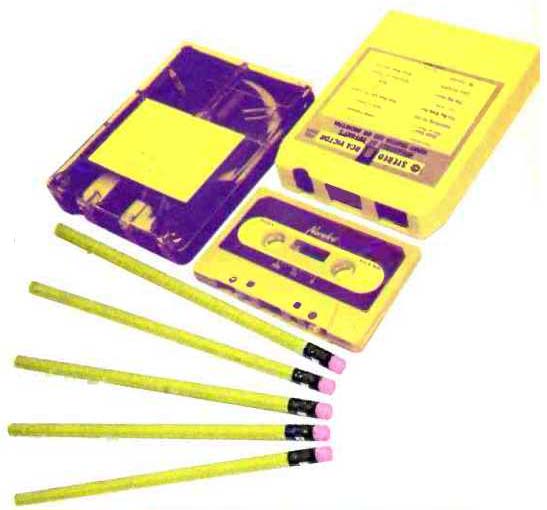
In 1947, while John Mullin was proving the worth of the Magnetophon tape recorder
he had brought back from Germany, a research team at Bell Laboratories (consisting
of physicists John Bardeen, Walter Brattain and William Shockley) was developing
a device which would revolutionize tape recording along with just about every
other aspect of electronics--the transistor.
Manufacturers of magnetic recording equipment didn't pay much attention--they were too busy developing wire and tape. Magnecord, which had been organized in 1946 to produce wire recorders (first for broadcast use and almost immediately for public consumption) abandoned that format in favor of tape in the fall of 1948. Magnecord's PT-6 quickly became the workhorse of recording studios and radio stations, as well as finding favor among hi-fi buffs.
One day the following year, David Apps of General Motors Laboratories approached Magnecord with an unusual request: Could the company build a tape recorder which could capture sound stereophonically? GM had been using a PT-6 to analyze automobile noise, but the results were unsatisfactory because they lacked spatial perspective. Perhaps a stereo unit might solve the problem. Magnecord quickly modified a PT-6, installing two record/play heads 1-5/16 inch apart along the tape path. The upper one recorded left-channel sound, the lower one the right. Having made its first stereo recorder, Magnecord made two more for display at the 1949 Audio Fair in New York.
The musical applications of the stereo recorder were obvious to Magnecord's engineering-oriented management team, so in 1950 they hired a musical coordinator, a young recording engineer and audiophile named Bert Whyte. Whyte's first chore was to use the stereo machine to record as many different types of music as possible. A highly personable and persuasive man, the Chicago-based Whyte proceeded to talk just about every musical agglomeration that blew through the Windy City into letting him show them what stereo sound could do for their music. Benny Goodman, Lionel Hampton, Jimmy McPartland, the U.S. Navy Band, Woody Herman, and the Chicago Symphony all passed before Whyte's Magnecord for a series of recordings, many of which still exist.
None, however, has ever been released commercially because of union problems and the fact that they were recorded as experiments.
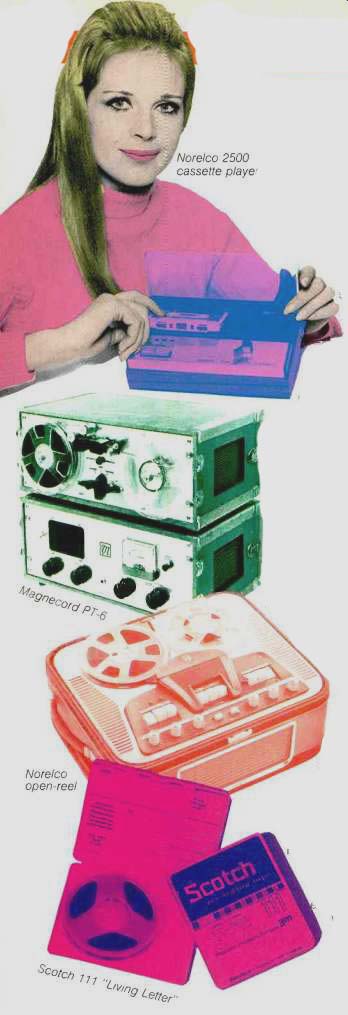
above: Norelco 2500 cassette player Norelco open-reel, etc.
Talking Woody Herman and Goodman into letting him record was child's play compared to Whyte's next challenge, explaining stereo to James Caesar Petrillo, then president of the American Federation of Musicians. Six years earlier, Petrillo had brought all commercial recording in America to a screeching halt while he held out for a recording trust fund for his members.
The major record companies, who had been bloodied in that battle, weren't about to tangle with Mr. Petrillo again. Whyte and Magnecord, on the other hand, had nothing to lose. So he made an appointment to see the union leader, bringing with him a tape he'd made of a Leopold Stokowski concert in Urbana, Ill. "He sat there and listened," Whyte remembers, "and as he listened, I could see his face clouding up. When the tape ended, he scowled and said to me, 'Of course, you realize that we'll have to work out a pay scale for stereophonic recordings. Since there are two channels on the tape, I'd consider that two recording sessions. Each man in the group would have to be paid twice.' "
Whyte realized that stereo would never go anywhere under that arrangement. The record companies simply wouldn't sit for it. "Yes, Mr. Petrillo," Whyte replied, "but don't you see? If stereo catches on, everything will have to be rerecorded since there are no stereo recordings now." Petrillo thought that over, considering the increased work for his members-and the jump in record company contributions to his new trust fund. The scowl gradually faded into a benign smile. "Yeah," he answered, and the meeting was over.
Halfway around the world, something was happening that would alter the tape scene just as profoundly as had any of the previous developments. In the fall of 1945, a handful of Japanese engineers had leased some space in a burned-out Tokyo department store to start a company. They weren't sure exactly what they were going to do, but one thing was certain: It would be different from the things other companies were doing.
Their first efforts were handmade pieces of broadcasting equipment to be used by the government radio network, NHK. One day in 1948, the company president, Masaru Ibuka, was delivering a piece of equipment to the NHK studios when he happened to see a device on the desk of one of the U.S. occupation officers who oversaw NHK operations.
It was a tape recorder. Suddenly Ibuka knew what the company was going to make. It took the company which was to become Sony two years to do so, partly because nobody in Japan knew how to make recording tape. Ibuka and his associates experimented first with cellophane as a base, but found it stretched under tension and expanded in humid weather. Next, they tried paper. The results were better, but the paper tore every time the tape caught in the transport. "It was a blessing in disguise," Sony's Board Chairman, Akio Morita, whose cousin supplied the paper, recalled recently. "We had to take painstaking care in designing and manufacturing all of the parts along the tape path, to be sure the tape wouldn't snag." Old-timers say that at first the paper was laid out on the floor of Sony's "new" factory, a warehouse in the Shinagawa district of Tokyo. Workers then ran back and forth along its edges, spraying on the magnetic powder and binder with an airbrush.
Morita today admits that those first tapes weren't very good, particularly when compared to 3M's product. But they improved, and by late 1949 Sony had a prototype tape recorder. Early in 1950, the first Sony recorders went on sale in Japan. They cost $400, a lordly sum in postwar Japan, weighed over 100 pounds and were about the size of a small steamer trunk.
Back in the United States, some visionaries were talking about the day when tape might replace the ubiquitous long-playing record. Recording Associates, as early as 1950, published a catalogue of recorded music on tape, and other entrepreneurs talked confidently of putting the major record companies out of business. The record companies responded initially by ignoring the whole thing.
As a result, companies who wanted to offer music on tape either had to record their own or acquire recordings from European sources who hadn't been able to make deals with the independent U.S. labels. The result generally was music of less than compelling interest performed by artists nobody'd ever heard of. One of the first to record specifically for tape-and to observe professional quality standards--was Chet Smiley of Livingston Audio Products. Smiley packed up a stereo Magnecord in 1951 and flew to Florence, Italy, to record a number of classical performances at the May Festival. To these he added organist Hack Swain in a number of programs of old favorites and finally the piece de resistance--Lenny Herman and the Mightiest Little Band in the Land, then performing at the Hotel New Yorker.
Then, in 1954, the dam broke, with RCA Victor the first major label to produce its own prerecorded open-reel tapes. In quick succession came Vox Productions, Mercury Records (for whom Whyte had been consulting) and Westminster. The tapes' cost was high-$12.95 for a half-hour stereo program, at a time when discs cost $4 and frequently contained 50 percent more music.
Everybody loved tape's high-fidelity sound-and the fact that, in the early 1950s at least, it was the only way of hearing true stereo. But cost was an important consideration. So was convenience. Together, those two factors spawned a number of unlikely products, beginning with a device which fit on top of conventional professional turntables, converting them into tape decks. The three-wheeled unit, made by Presto, included takeup and feed tape reels, a playback head assembly and a capstan wheel driven by the turntable spindle. Then there was the Garrard cartridge, two full-sized reels of tape sealed inside a plastic shell.
The British record changer manufacturer had visions of producing a tape transport which would hold and drop these cartridges in sequence for automatic play. Midway through the 1960s, Sony would offer a machine which changed conventional tape reels automatically. If you wanted one with your name engraved on a silver plaque on the chassis, it would have cost you $995.
Primitive as the Garrard cartridge was, it was the first step toward what would be the biggest revolution of all in audio recording, Philips's development of the Compact Cassette. But first came the RCA cartridge, an oversized precursor of the Philips cassette, which used standard quarter-inch wide tape at a speed of 3 3/4 inches per second. Then came a short-lived square cartridge developed by Columbia Records and 3M (the takeup reel was inside the player). And then, in 1963 and 1964, the Compact Cassette. All were attempts to get over the public's fear of tape handling and threading, and were designed to make tape players more compact, efforts which would pay off some 15 years later in the video era.
Video, in fact, was only being hinted at in tape recording circles during the 1950s. In fact, Bing Crosby Enterprises had shown a black-and-white open reel video recorder as early as 1951 and on January 4, 1927, a Russian immigrant to Britain, Boris Rtcheouloff, had applied for a patent based on Poulsen's invention, describing a system for recording pictures and sound on wire or "a travelling strip of magnetic material." The Rtcheouloff application even goes so far as to describe a rudimentary video camera.
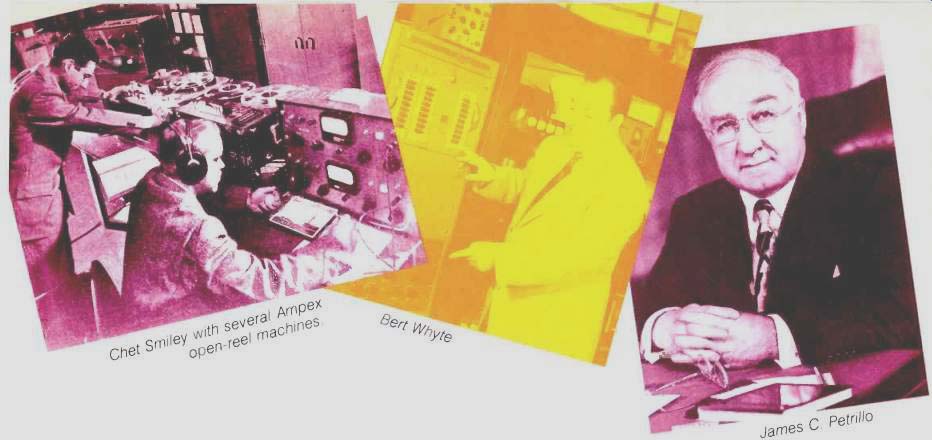
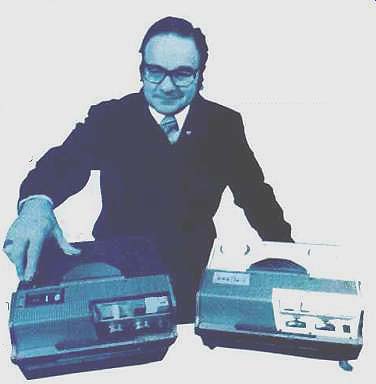
Wollensak Model 1515s, c. 1974, left, and c. 1954.
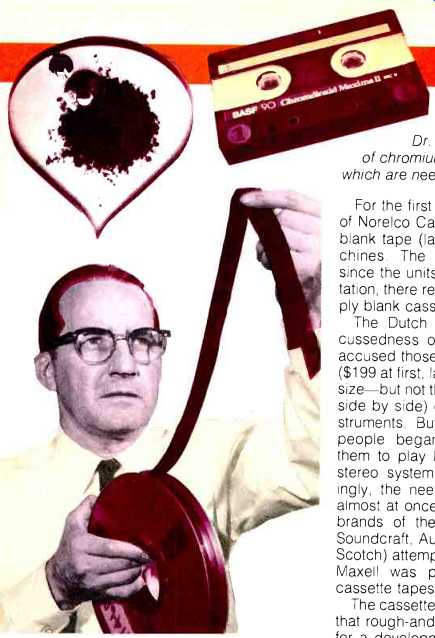
Du Pont chemist Dr. Paul Arthur, Jr., inventor of chromium dioxide, six grams
of which are needed for a C90 cassette.
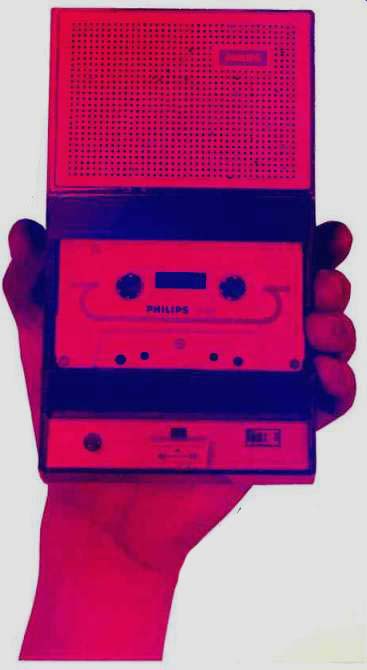
An original Philips "Carry-corder" (Photo; Courtesy C.G. Nijsen, Philips and J. A. E. S.)
It wasn't until 1956 that video recording became a reality at the professional level, with the Ampex VRX-1000. It was first used by CBS for "Douglas Edwards and the News," on November 30. Shortly thereafter, NBC became the first network to broadcast an entire program recorded on videotape, "The Jonathan Winters Show." And just after the New Year, 3M would begin marketing reels of videotape at $307 each.
The first hint of video recording for the home also came in 1956, when RCA announced that it was working on what it called a See-Hear video tape player, which would enable homeowners to play prerecorded programs through their television sets. Like other RCA pronouncements on video, this one wasn't followed up with actual products.
Beginning in 1954, with the first use of Bell Telephone Laboratories' transistor in a consumer product-this one a radio, manufactured in Texas for Regency-the move toward complete elimination of vacuum tubes in recording devices began. That same year, and not coincidentally, Sony produced the first Japanese-made transistors, under license from Bell. It would take 10 years before transistors completely displaced tubes in tape equipment, but the handwriting clearly was on the wall, and it said " Solid State." By the early 1960s, the sale of open reel tape recorders was booming, along with other audio products. Con sumers, unaware of the changes taking place beneath the surface, were paying as much as $399 for so-called professional models from Concertone or Bell Sound Systems. You could buy a do-it-yourself kit from Eico for $300 or pay $200 for the Wollensak 1515, a recorder which was fast becoming the Coke bottle of the tape field. Not a thing of beauty, the mono version went on sale in 1954. With very minor changes in its cosmetics and profile (but significant improvements in its interior, including a stereo version in 1963), it lasted until 1978, when the last ones were made for schools.
But the days of the home open-reel boom were numbered, In Holland, Philips had developed a compact dictating system which it would introduce in Europe during 1963 and in the United States the following year. Also in 1963, the first video recorder intended for the home made a fleeting appearance in the basement of the Cinerama Theatre on Broadway, in New York.
Of these, the one producing the greatest impact initially was Philips' Carry-Corder. Over the next 20 years, it would spell the end of open-reel tape recording in the home, open the whole new field of portability and spur the development of new types of tape better suited to the Compact Cassette's peculiar requirements.
For the first year or two, purchasers of Norelco Carry-Corders got a single blank tape (later three) with their machines. The manufacturer felt that since the units would be used for dictation, there really was no need to supply blank cassettes in quantity.
The Dutch hadn't counted on the cussedness of people. Nobody ever accused those first cassette recorders ($199 at first, later $149, and about the size-but not the weight-of two bricks side by side) of being high-fidelity instruments. But almost from the first, people began recording music on them to play back where their home stereo systems couldn't go. Accordingly, the need for blank tape arose almost at once-and the leading tape brands of the day (Ampex, Reeves Soundcraft, Audio Devices, BASF and Scotch) attempted to meet it. By 1966, Maxell was producing Japan's first cassette tapes.
The cassette might have remained in that rough-and-ready state if it weren't for a development taking place in, of all places, India. There, a young engineering graduate of Stanford University and Cambridge was finishing out a tour of duty with the Peace Corps. Ray Dolby (formerly a member of Ampex's first video-recorder design team) was a music lover who was intrigued by the problem of noise in tape recording, which seemed to be inherent. The nights in India were long, and Dolby had lots of time to think about the persistent hiss he heard in the quiet passages of his favorite tapes.
Then he hit on the idea of breaking up the frequency spectrum during recording, with certain frequencies and certain volume levels of the signals recorded at higher levels than other combinations. Then, during playback, these signals would be suppressed by exactly the same amount, along with the accompanying background noise or hiss. Dolby's invention found immediate application in professional recording, where Decca Records in England bought every unit he could produce during his first five months in business.
What turned the cassette into a high fidelity recording medium, however, was the development of a low-cost version of the system Decca was using, one which could be built into home recording equipment. The idea came from Henry Kloss, then president of KLH. The recorder in which he planned to use it was an open-reel model, but when Kloss moved on to establish Advent, he took the idea of a low-cost Dolby noise-reduction circuit with him and applied it to that company's first cassette deck.
During this period, Dolby appeared before the Audio Engineering Society to describe his system, and mentioned casually that there was no reason why the circuit KLH was using couldn't be reduced to an integrated-circuit chip and incorporated in every cassette recorder. In 1973, 'Signetics produced such a chip. Harman-Kardon then beat Advent to the punch by using the new chip to upgrade a cassette deck it had just introduced.
The coming of cassette helped bring Scotch 111 and the other first-generation red-oxide tapes to the end of their long careers. At 3M and at Philips, work had begun on a new tape particle, pure metal, rather than the oxides which had been used for 30 years. The chemists and engineers were trying to do the same thing that Dolby did, improving the signal-to-noise ratio of tape recordings by making backgrounds quieter. "We all knew that it was the ferrite bits in the oxides which did all the work," 3M technical manager Del Eilers says now, "that the oxidized bits caused all the noise because no signal was recorded there. So we figured that if we could coat a tape with particles of pure iron, we could dramatically reduce residual noise levels, while doing something dramatic about frequency response and other characteristics." The catch was that pure iron filings or powder proved highly unstable. Exposed to oxygen in the air, they would immediately oxidize, sometimes with explosive results.
There is no evidence that anyone was ever killed or injured in these explosions, but both Philips and 3M experienced them, and there was apparently some damage to equipment. So the idea of metal tape was put on the back burner.
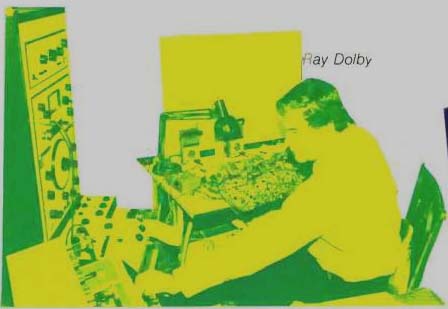
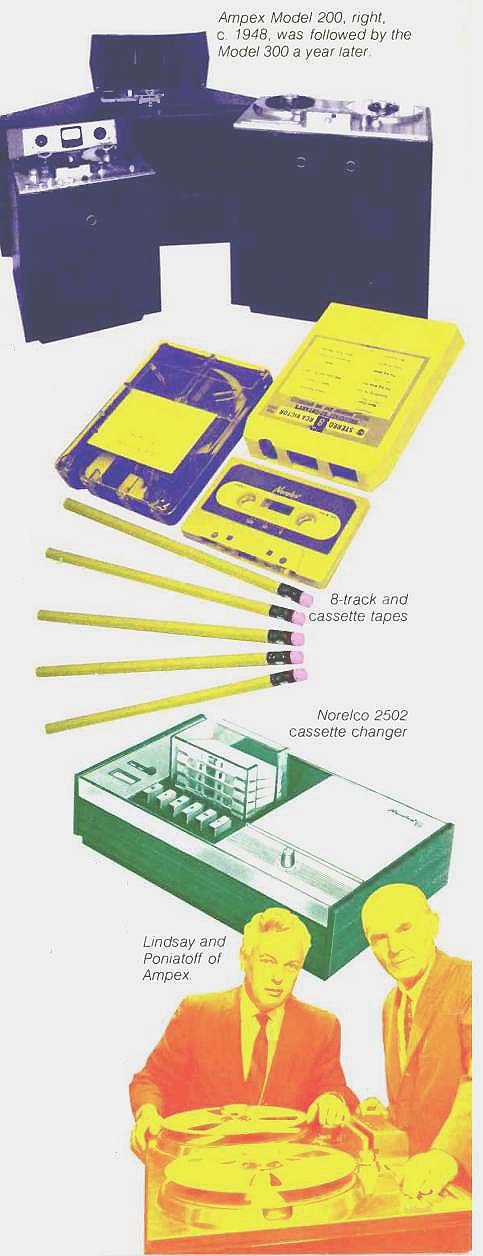
Ampex Model 200, right, c. 1948, was followed by the Model 300 a year later.;
8-track and cassette tapes; Norelco 2502 cassette changer; Lindsay and Poniatoff
of Ampex.
Meanwhile, E.I. du Pont de Nemours & Co. had patented a process for producing chromium dioxide, a product not found in nature. The trouble was that, at first, nobody seemed to know what to do with it. The scientists at du Pont thought that because of its high coercivity, it might have an application in magnetic recording. Accordingly, in 1969, the company sent a marketing/ engineering team to New York to explain to the tape industry how chromium dioxide could be used to make superior audio recordings, particularly in cassette recorders designed specifically to accept it, as well as in video applications. Interest was high, and du Pont signed licensing agreements with BASF, making it the exclusive manufacture in Europe, and with Sony, which had all rights to the product in Japan. That meant that any Japanese tape manufacturer wishing to produce chrome tape would have to talk to Sony first. If they produced the tape commercially, they would have to pay Sony royalties as well.
The predictable result was a race to develop a chrome substitute. The first step in that direction came in the early 1970s when Pfizer Inc. developed 2228, a high quality gamma ferric-oxide particle which could be mass-produced. Previously, some tape makers had formulated their own particles from raw materials supplied by chemical companies like Pfizer, while in other cases, small firms, many engaged in producing paint pigments (as was Pfizer), purchased finished particles.
In any case, the development of 2228, which was nothing more than a very good quality ferric-oxide particle, made it possible for almost anybody to go into the tape business and produce a high-quality coating. It was compatible with the ferric-oxide tapes which had been produced during the 1950s and 1960s in terms of signal biasing and equalization, but it offered much better uniformity and particle size ratio.
It could also be combined with cobalt particles to achieve even better frequency response and signal-to-noise ratio-but only when biased and equalized at a level somewhat higher than previously used and specified by Philips in its patent licensing agreements. Since its introduction, virtually every improvement in ferric oxide tape has involved the use of 2228 or an equivalent as a basic building block.
Indeed, du Pont had run afoul of the Philips patents when it first tried to use chrome for cassette recording. So after protracted negotiations, the Dutch company amended its standards to permit biasing and equalization for chrome. As it happened, these specifications worked equally well for cobalt enhanced 2228 particles, and soon every Japanese tape manufacturer other than Sony was offering its own version of chrome-biased ferric-oxide tape. By 1976, it had become necessary for companies like Maxell to clearly identify each tape's bias and equalization characteristics on the cassette or package.
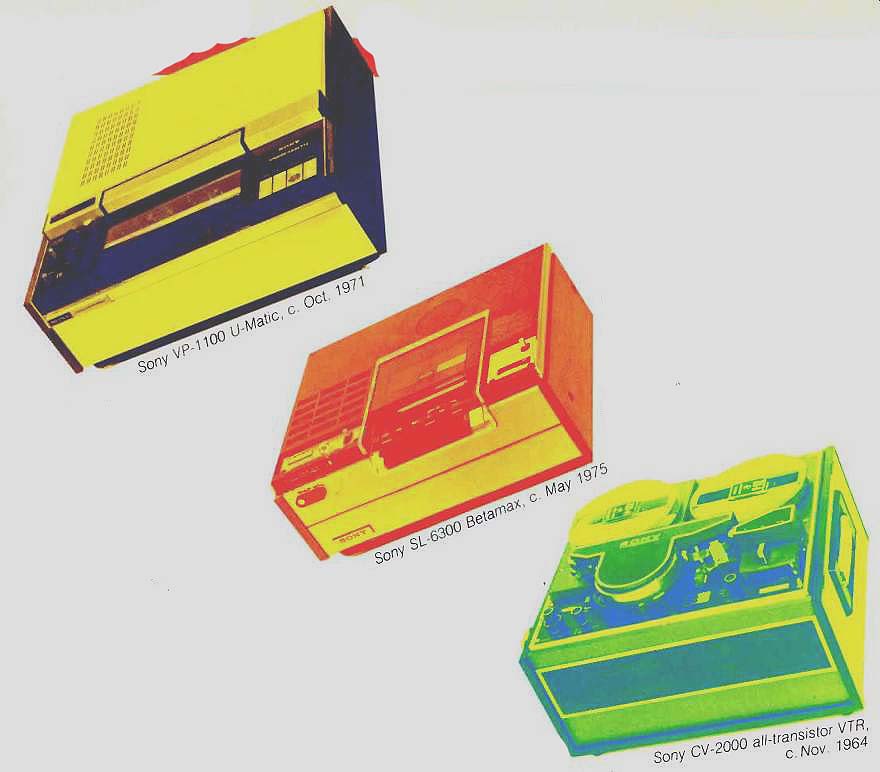
By far the most bizarre event of that decade of change was the announcement, late in 1963, by a previously unheard-of British electronics firm, Telcan Ltd., that it had developed a home video recorder which could sell for the incredibly low price of $94. It used half inch tape at a voracious rate--an 11 1/2 inch reel provided only 11 minutes of playing time. The day of Telcan's demonstration was a cold and wintry one; the pictures reaching the black-and white monitor in the basement of the Cinerama theatre from local TV stations were smeary, unclear and unacceptable. So were the recordings the Telcan unit made of them and played back to the assembled press corps.
Sniffed the highly respected Television Digest in its report, "Telcan't." Telcan didn't go away immediately, but neither did recorders appear in stores. Instead, the company reorganized and talked about a kit version for $164 (it never appeared, either), while other kitchen inventors offered working models of their own so-called brute force recorders.
The whole idea might have died there. Instead, Ampex, Panasonic and Sony, using the helical scan recording idea advanced nearly 40 years earlier by Boris Rtcheouloff, introduced black-and-white video recorders designed for home use and priced between $1,000 and $1,200, or about three times the cost of the best audio cassette deck at the time. These recorders provided much better results than Telcan's, but they had their own problems. One was that tapes recorded on one machine might not play back on another unit, even if both were the same brand. Another was that the Ampex, at least, was a' service technician's nightmare. Once something went wrong with it, it usually went into the closet and was forgotten.
Akio Morita believed that it was Sony's task not only to develop and produce products which were revolutionary, but also to teach people how to use them. Accordingly, Sony bought television time in New York to explain to viewers who didn't know that they needed home VCRs what the recorders were for and how easy they were to use. The commercials zeroed in on the time-shifting feature, which Morita has always felt was the most important.
They didn't sell many recorders-all three models disappeared within a year or two-but they did raise consciousness when it came to video recording and to Sony.
Sony's first real video recorder hit was the introduction of U-Matic recorders in 1970, in conjunction with a number of other Japanese manufacturers who had agreed in advance on a single format. This time, recordings were fully interchangeable from one ma chine to another and from one brand to another. The recordings were in color his time, and the tape was protected by a cassette-type shell. However, the manufacturers made no real effort to sell U-Matic as a home medium; instead, the recorders were sold to educational and industrial users, to cable television systems and even to local broadcasters.
Two years later, home viewers got heir chance, with a console called Cartrivision. It contained a 25-inch color TV set in addition to the cartridge video recorder, at a cost of $2,400. Very few people had that kind of money, and many of those who did had no use for another 25-inch receiver. Besides, the sets didn't always work, and very few programs were available for the system.
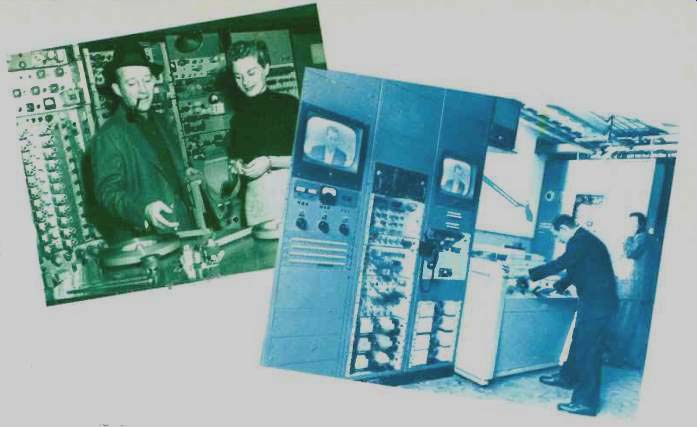
The Crosby Enterprises VTR used high tape speed past fixed heads,
but was abandoned when Ampex showed its unit in 1956. First use of Ampex's
VRX-1000 was for "Douglas Edwards and the News" in November 1956,
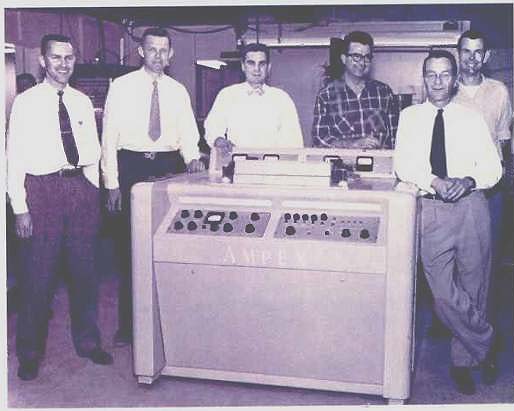
The Ampex VRX-1000 included three items basic to all current
VTRs: Spinning heads, FM recording of the video signal, and time-base error
correction.
The design team included Fred Pfost, Shelby Henderson, Ray Dolby, Alex Maxey, team leader Charles Ginsberg, and Charles Anderson.
Home video finally became a reality n 1975, when Sony introduced the Betamax. Panasonic and JVC followed up quickly with VHS machines early in 1976. Since then, improvements in these systems have come thick and fast-the first portable VCRs (1979), the first VCRs with high fidelity stereo sound (1982) and, in 1983, the first one-piece Beta camera-recorders. To them were added in 1984 the first 8 mm camera-recorders from Kodak and the first really compact VHS-system camera-recorders from JVC, using the ultra-small VHS-C videocassette.
Like the story of video recording, that of recording tape remains unfinished as these lines are written. As home video developed, recorder manufacturers found that the high-bias audio chrome and cobalt-absorbed ferric-oxide tapes, which began appearing around 1970, were ideal for recording video as well.
In 1979, 3M's technicians finally found a way of producing metal-particle tape without explosions, and without the tape oxidizing the first time the user took it out of the box. The secret: Allow the thin surface skin to oxidize just enough to protect the rest of the metal coating underneath and combine traces of other metals with iron to inhibit oxidization. 3M contacted a number of recorder manufacturers before going public with its tape. Of the lot, Tandberg was the first to develop a recorder designed to take full advantage of the ultra-high-bias tape.
3M thought it had stolen a march on other tape manufacturers. It was aware, of course, of Philips research on metal particles, but it believed that the Dutch had not yet solved the stabilization problem. The company was astounded, therefore, when a Japanese maker, Kanto Denko, not previously involved in tape manufacture at all, announced that it had a metal particle, and proceeded to sell it to any Japanese manufacturer who cared to buy.
Metal particle tape has yet to find a niche in video recording, though the recent introduction of an 8-mm recorder-camera designed to use it suggests that it is about to do so. In the meantime, there is another form of metal tape which has been used for several years in the manufacture of microcassettes. "We originally called it metal plated," a 3M technician told me, "when we began research on it back in 1963." He explained that the process involves passing a charged plastic film through an ionized vapor of iron. The result is a very thin deposit of pure metal on the surface of the film. The coating is much thinner than one of metal particles, but it's also more even, with virtually no gaps or dropouts.
Panasonic patented a process which works in the early 1980s and labeled the result Angrom. Indications are that we'll be hearing more about both types in the years to come.
And what about the Compact Cassette, which for practical purposes buried the open-reel home recorder in the early 1970s? Well, you can mark 1984 down as the year in which it finally surpassed the long-playing record in terms of prerecorded sales, due in no small part to another idea of Sony Chairman Akio Morita. Back in 1980, Morita reasoned that what the world needed was a very compact, very lightweight high-fidelity cassette tape player that could be enjoyed through high-quality, comfortable headphones.
Virtually everybody at Sony tried to talk him out of it. For one thing, they pointed oat, nobody had ever heard of a portable player without a loudspeaker.
And if you put in a speaker that sounded like anything, the unit would be heavy. No record function? Likewise unheard of, Morita stuck to his guns (after all, he was the chairman of the board). He even had a name for the new player: Walkman. Some of his associates cringed. It would never play in America, they said, and persuaded him to let the players be introduced under another name there. Within 18 months, everybody had forgotten the first name (Soundabout); the Sony Walkman was the hit of three continents and the Sony headquarters building in Shinagawa had a museum in the basement containing blatant copies by several dozen competitors.
The magnetic recording industry entered a new era--or at least the audio portion of it did--in 1978 when Sony introduced the first PCM digital recorder. Since then, PCM units have come down in price, size and complexity to the point where virtually any audiophile can afford one, alongside his hi-fi video recorder and professional-quality Compact Cassette deck. In the 1980s, it's virtually an embarrassment of riches for the tape-oriented audiophile.
(adapted from Audio magazine, Sept. 1984)
Part 1 (coming soon)
Also see: The March of Technology: Analog Tape Home Recording (May 1997)
How Important is Tape Azimuth? (Sept. 1984)
= = = =